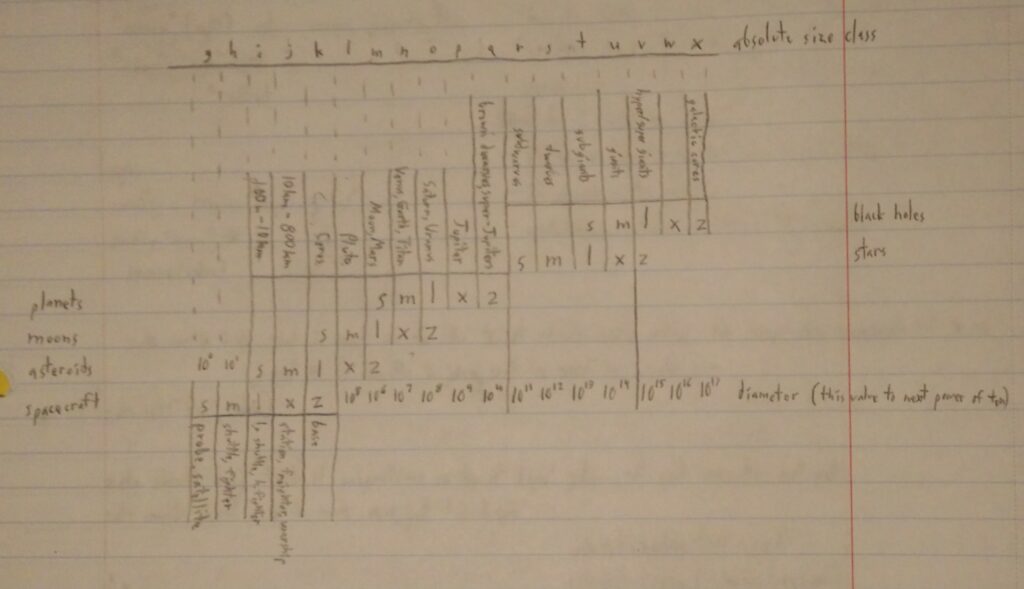I’ve spent a lot of time trying to answer certain questions in astronomy, where I just want a rough approximation for the purpose of a simulation, and don’t need an exact answer. These are some of the equations I’ve come up with.
Yerkes Classes’ T/Mv Relations
These equations are shown as functions where x is temperature in Kelvin, and f(x) is absolute magnitude (visual). Most are valid from 2400 K to a little bit past 30000 K, the exceptions are noted. For the hypergiants and white dwarfs, the range is within an elliptical region, of which these functions define the major axis; for all others, they are a trend line along a Yerkes classification.
- Hypergiants (0):
f(x) = -8.9 - Supergiants (Ia):
f(x) = -0.00135x3 + 0.0233x2 + 0.0187x – 7.349 - Supergiants (Ib):
f(x) = 0.00329x3 – 0.0962x2 + 0.829x – 7.209 - Bright Giants (II):
f(x) = 0.00557x3 – 0.166x2 + 1.505x – 6.816 - Giants (III):
f(x) = 0.0135x3 – 0.373x2 + 3.019x – 7.233 - Subgiants (IV):
f(x) = -0.151x2 + 2.216x – 5.128 (4450-100000 K only) - Dwarfs (V):
f(x) = 0.00193x5 – 0.0615x4 + 0.742x3 – 4.257x2 + 12.439x – 12.996 (note: this one is the least accurate) - Subdwarfs (VI):
f(x) = 0.131x3 – 3.275x2 + 27.576x – 71.7 (3050-6000 K only) - White Dwarfs (VII):
f(x) = 0.489x + 10.01 (4450-30000 K only)
Simple Conversions
- Absolute Magnitude (visual) → Luminosity (solar luminosities):
Lsun = 100 * exp(-0.944 * Mv)
Accurate between 0-10 Mv. Probably continues accuracy relatively well. - Main Sequence Luminosity / Mass Relation:
Lstar / Lsun = (Mstar / Msun)3.5
Lstar = ( 3.68 * ln(Mstar) – 0.244 )e
(The second equation applies to all stars.) - Mass / Lifetime Relation:
Tyears = ( 23.4 – 2.68 * ln(Mstar) )e
(This applies to all stars.)
Spectral filters are used to help classify stars. Ultraviolet, Blue, Visual, Red, and Infrared. Objects are listed in different indexes:
- U–V for the hottest objects (stellar remnants, galaxies)
- B–V (the majority of stars)
- R–I for the coolest (LTY “stars” and below)
Equations I no longer recommend
Provided for completeness, in case they are found to be useful.
- Temperature (K) → Absolute Magnitude (visual):
Mv = 35.463 * exp(-0.000353 * T)
Roughly accurate between 2000-50000 Kelvin. Probably doesn’t continue accuracy at hotter temperatures. Previously this was at the top of this post, now I am not sure why (perhaps the simplicity). The Yerkes’ classifications are a better system. - B-V index (x) → Temperature (K):
T = -772.2x3 + 3152x2 – 6893x + 9500
Sorta accurate between 0-2. (This equation I am least comfortable with, and don’t plan to use.)


